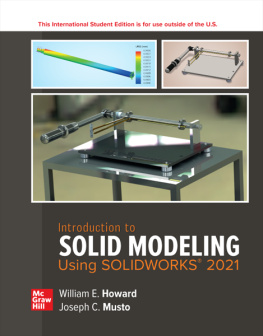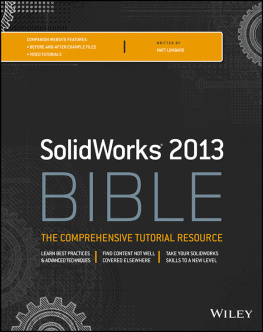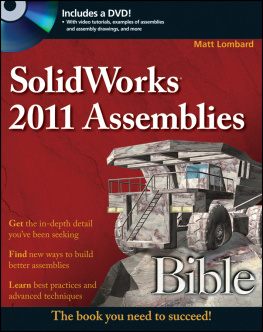
page i
Introduction to
Solid Modeling
Using SolidWorks 2021
William E. Howard
East Carolina University
Joseph C. Musto
Milwaukee School of Engineering

page ii

INTRODUCTION TO SOLID MODELING USING SOLIDWORKS 2021
Published by McGraw Hill LLC, 1325 Avenue of the Americas, New York, NY 10019. Copyright 2022 by McGraw Hill LLC. All rights reserved. Printed in the United States of America. No part of this publication may be reproduced or distributed in any form or by any means, or stored in a database or retrieval system, without the prior written consent of McGraw Hill LLC, including, but not limited to, in any network or other electronic storage or transmission, or broadcast for distance learning.
Some ancillaries, including electronic and print components, may not be available to customers outside the United States.
This book is printed on acid-free paper.
1 2 3 4 5 6 7 8 9 LWI 26 25 24 23 22 21
ISBN 978-1-265-24263-3
MHID 1-265-24263-1
Cover Image: Joseph C. Musto
All credits appearing on page or at the end of the book are considered to be an extension of the copyright page.
The Internet addresses listed in the text were accurate at the time of publication. The inclusion of a website does not indicate an endorsement by the authors or McGraw Hill LLC, and McGraw Hill LLC does not guarantee the accuracy of the information presented at these sites.
mheducation.com/highered
page iii
About the Authors
Ed Howard is an Associate Professor in the Department of Engineering at East Carolina University, where he teaches classes in solid modeling, engineering computations, solid mechanics, and composite materials. Prior to joining ECU, Ed taught at Milwaukee School of Engineering. He holds a B.S. in Civil Engineering and an M.S. in Engineering Mechanics from Virginia Tech, and a Ph.D. in Mechanical Engineering from Marquette University.
Ed worked in design, analysis, and project engineering for 14 years before beginning his academic career. He worked for Thiokol Corporation in Brigham City, UT; Spaulding Composites Company in Smyrna, TN, and Sta-Rite Industries in Delavan, WI. He is a registered Professional Engineer in Wisconsin.
Joe Musto is a Professor in the Mechanical Engineering Department at Milwaukee School of Engineering, where he teaches in the areas of machine design, solid modeling, and numerical methods. He holds a B.S. degree from Clarkson University, and both an M.Eng. and Ph.D. from Rensselaer Polytechnic Institute, all in mechanical engineering. He is a registered Professional Engineer in Wisconsin.
Prior to joining the faculty at Milwaukee School of Engineering, he held industrial positions with Brady Corporation (Milwaukee, WI) and Eastman Kodak Company (Rochester, NY). He has been using and teaching solid modeling using SolidWorks since 1998.
Joe and Ed, together with Rick Williams of Auburn University, are the authors of Engineering Computation: An Introduction Using MATLABand Excel.
page iv
page v
CONTENTS
page vi
Appendix

page vii
Special Features
Design Intent
Planning the Model 19
Selecting a Modeling Technique 24
Planning for Other Uses of the Model 40
Choosing the Initial Sketch Plane 42
Keeping It Simple 46
Exploiting Associativity 62
Symmetry in Modeling 104
Planning an Assembly Model 199
Part-Level and Assembly-Level Features 209
Manufacturing Considerations 215
Assembly-Level Dimensions 244
Future Study
Dynamics (Kinetics) 47
Manufacturing Processes, Geometric Dimensioning and Tolerancing, and Metrology 67
Industrial Design 128
Industrial Engineering 267
Mechanics of Materials 271
Machine Dynamics and Machine Design 311
Materials and Processes 337
VIDEOS
Example 1 6
Example 2 56
Example 3 105
Example 4 120
Example 5 192
Example 6 360
Example 7 366
page viii
page ix
PREFACE
As design engineers and engineering professors, the authors have witnessed incredible changes in the way that products are designed and manufactured. One of the biggest changes over the past 30 years has been the development and widespread usage of solid modeling software. When we first saw solid modeling, it was used only by large companies. The cost of the software and the powerful computer workstations required to run it, along with the complexity of using the software, limited its use. As the cost of computing hardware dropped, solid modeling software was developed for personal computers. In 1995, the SolidWorks Corporation released the initial version of SolidWorks software, the first solid modeling program written for the Microsoft Windows operating system. Since then, the use of solid modeling has become an indispensable tool for almost any company, large or small, that designs a product.
While 2-D drawings can be an effective tool to document and communicate design details, a solid models usefulness extends throughout the design process. The solid model data can be saved in a format from which a physical model can be made with a 3-D printer. Structural, thermal, dynamic, and fluid flow analysis can be performed with finite element analysis (FEA) and other simulation software. Photorealistic pictures, including materials, textures, lighting, and backgrounds can be created to allow complete visualization of designs before they exist. The image on the cover shows a laboratory test fixture designed for torsion testing of shafts in a college laboratory. The test fixture, designed by Dr. Mohammad Mahinfalah at Milwaukee School of Engineering, allows students to apply torque to one end of a machine shaft with a torque wrench, and measure the resulting twist in the shaft. This demonstrates theory learned by students in their mechanics of materials courses. The test fixture was designed using SolidWorks , and the SolidWorks assembly model of the test fixture is shown on the cover. A simulation of the machine shaft was performed using SolidWorks Simulation to see how the fixture would operate, and the resulting simulated test is also shown on the cover. The final assembly model was then rendered using the SolidWorks PhotoView 360 tool. The cover image showing the test fixture in a laboratory setting is not a photograph, but the photorealistic image created with the software. This visualization tool allows the designer and customers to see the product as it will appear in use before it is manufactured.
SolidWorks is a registered trademark of Dassault Systmes SolidWorks Corporation.
eDrawings is a trademark of Dassault Systmes SolidWorks Corporation.
page x
Motivation for This Text
When we saw a demonstration of the SolidWorks software in 1998, we were both instantly hooked. Not only was the utility of the software obvious, but the program was easy to learn and fun to use. Since then, we have shared our enthusiasm for the program with hundreds of students in classes at Milwaukee School of Engineering and East Carolina University, in summer programs with high school students, and in informal training sessions. Most of the material in this book began as tutorials that we developed for these purposes. We continue to be amazed at how quickly students at all levels can learn the basics of the program, and by the sophisticated projects that many students develop after only a short time using the software.
Next page













